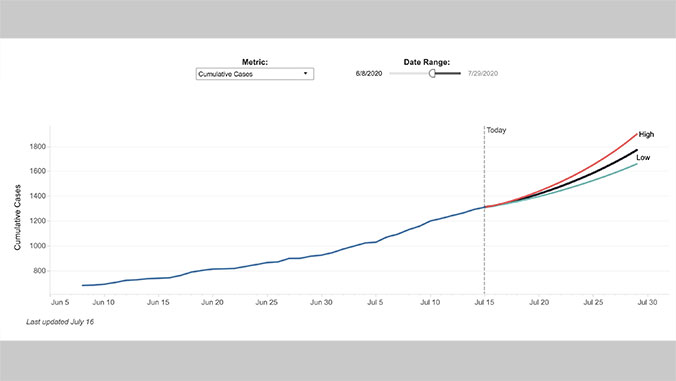
An innovative COVID-19 forecasting tool, developed by University of Hawaiʻi researchers, aims to assist experts to model potential COVID-19 effects on the State of Hawaiʻi.
Baseem Missaghi, a software developer at UH’s Applied Research Laboratory, created the web application in partnership with the Hawaiʻi Pandemic Applied Modeling Work Group and others. It utilizes data on historical COVID-19 cases, hospitalizations, fatalities, recoveries and active cases. The tool provides a two-week forecast and examines possible scenarios for COVID-19 cases, hospitalizations and fatalities. Missaghi said the customizability is most valuable for experts.
“The scenario tool doesn’t predict how many cases Hawaiʻi will have in two weeks, rather it helps Hawaiʻi’s epidemiologists tweak various parameters that allow them to visualize what the future state of Hawaiʻi might be,” Missaghi said. “With this information, we can be more prepared for hospital overflow and ICU capacity.”
Along with medical professionals, Missaghi hopes the modeling will help inform policy decisions such as quarantine orders and travel restrictions.
Foundation of the model
Missaghi worked closely with Thomas Lee, an Office of Public Health Studies assistant professor, to develop the forecasting tool based on an open-source tool from Switzerland’s University of Basel. The tool utilizes the SEIR (Susceptible, Exposed, Infected, Recovered) model, which is based off of the following progressive factors: susceptible individuals are exposed through contact with infectious individuals; exposed individuals progress to a symptomatic state; infectious individuals recover or experience more severe symptoms; and severely sick individuals either recover or their condition worsens.
“Several online tools exist that incorporate the SEIR model, however, what we did was take those tools and customize it for Hawaiʻi to support Hawaiʻi—applying the lessons from around the world and also factoring in Hawaiʻi’s unique circumstances,” Missaghi said.
—By Marc Arakaki

